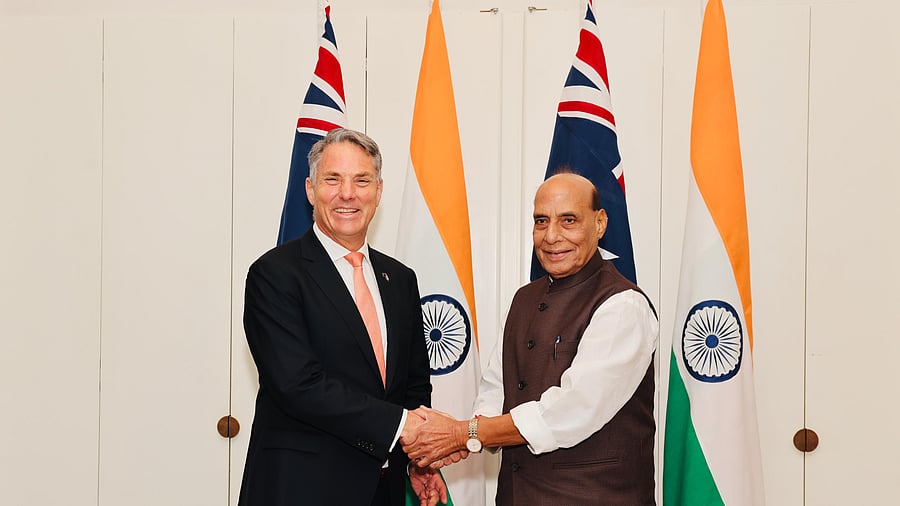
Defence Minister Rajnath Singh and his Australian counterpart, Deputy Prime Minister and Defence Minister Richard Marles
Credit: PIB website
In what is seen as a significant boost to their strategic partnership, India’s Defence Minister Rajnath Singh and his Australian counterpart, Deputy Prime Minister and Defence Minister Richard Marles, on Thursday, October 9, announced a series of new measures to deepen defence and security cooperation between India and Australia.
Meeting in Canberra for the inaugural Australia–India Defence Ministers’ Dialogue, the two leaders reviewed the progress made under the Comprehensive Strategic Partnership, which marks its fifth anniversary this year and charted a new roadmap for cooperation across the Indo-Pacific.
“The Dialogue reflected unprecedented progress in the bilateral defence partnership,” a joint statement by both the Defence Ministers said, adding that both of them had advanced “their Prime Ministers’ long-term vision for collaboration between the two countries to enhance collective strength and contribute to regional peace and security.”
Strengthening maritime cooperation
The ministers discussed a Joint Maritime Security Collaboration Roadmap aimed at advancing cooperation in the Indo-Pacific, while reaffirming their commitment to freedom of navigation and overflight “consistent with international law, particularly the 1982 United Nations Convention on the Law of the Sea.”
Both sides welcomed the signing of a new Implementing Arrangement on Mutual Submarine Rescue Support and Cooperation, a step that aims to enhance joint underwater operations and maritime safety. They also noted progress in operationalising the air-to-air refuelling arrangement, signed in 2024, which was demonstrated earlier in the day through a live refuelling exercise involving a KC-30A aircraft and an F-35 fighter jet.
Defence industry and technology collaboration
Highlighting the growing defence industrial relationship, the ministers underscored the “strategic importance of defence industrial collaboration and engagement.” The statement noted that Australia’s first defence trade mission to India, held from October 7–10, and India’s participation in Australia’s Land Forces Expo 2024 marked “growth in the bilateral defence industry relationship.”
Both sides will hold the Australia–India Defence Industry Roundtable in Sydney on October 10 to explore collaboration in “contemporary technology,” including research, materials, and joint manufacturing.
Australia thanked India for offering maintenance, repair, and overhaul (MRO) facilities for Royal Australian Navy ships operating in the Indian Ocean, a move that could boost India’s growing defence manufacturing ecosystem.
Expanding military exercises and interoperability
The statement emphasised that defence cooperation now “extends across all domains.” India’s participation in Australia’s Exercise Talisman Sabre 2025 and future participation in 2027 was welcomed, as was the Royal Australian Air Force’s participation in India’s Exercise Tarang Shakti 2024.
India also accepted an invitation to take part in Australia’s submarine rescue exercise Black Carillon, signalling deeper operational cooperation. Both sides reaffirmed their commitment to expanding army-to-army exercises like Exercise Puk Puk and enhancing Exercise Austrahind “in both scope and complexity.”
They also committed to closer engagement in emerging domains such as integrated air and missile defence, uncrewed aerial systems (UAS), and counter-UAS technologies through expert exchanges.
Regional security and the Quad
Both countries reaffirmed their commitment to a “free, open, peaceful, stable and prosperous Indo-Pacific”, and to closer coordination with regional partners. They underscored “strong support for freedom of navigation and unimpeded trade in the region,” a message seen as aimed at countering China’s growing assertiveness in the South China Sea.
The ministers “welcomed ongoing progress” among Australia, India, Japan, and the United States under the Quad framework, noting the “growing strategic convergence” between the partners. They looked forward to further collaboration on maritime domain awareness, including a second joint activity during Exercise Malabar in November 2025.
During the bilateral meeting, Rajnath Singh reiterated India’s uncompromising stance on terrorism, asserting that “terror and talks cannot go together, terror and trade cannot go together, and water and blood cannot flow together.” He called for international unity in combating terrorism in all its forms.
